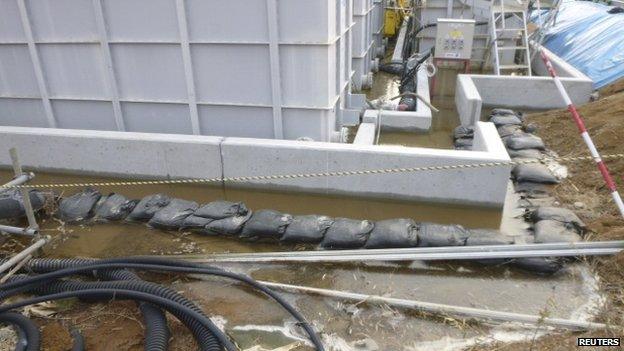Japan's Fukushima nuclear plant leaks radioactive water
- Published

The leak is thought to have occurred after a storage tank overflowed
Around 100 tonnes of highly radioactive water have leaked from a storage tank at Japan's Fukushima nuclear plant, operator Tokyo Electric (Tepco) says.
The toxic water may have overflowed after a valve was left open by mistake, Tepco said.
However the water was unlikely to have reached the ocean, the operator added.
The plant, which was damaged by an earthquake and tsunami in 2011, has faced multiple problems including leaks and power cuts since the disaster.
The latest leak is the most serious since August, when the plant leaked 300 tonnes of water, prompting Japan's nuclear agency to raise the incident's alert level.
'Contaminated earth'
The water from Wednesday's leak was radioactive, with a reading of 230 million becquerels per litre of radioactive isotopes, Tepco spokesman Masayuki Ono told reporters.
A becquerel is a unit used to measure radioactivity. WHO guidance, external advises against drinking water with radioactivity levels higher than 10 becquerels per litre.
Tepco says the radioactive water overflowed from a storage tank on Wednesday, but the leak was not discovered for several hours, the BBC's Rupert Wingfield-Hayes in Tokyo reports.
The operator says the leak occurred when contaminated water was accidentally pumped into a large storage tank that was already full, our correspondent adds.
"We apologise for worrying the public with such a leak," Mr Ono said. "Water is unlikely to have reached the ocean as there is no drainage in that tank area."
"We are now in the process of recovering the leaked water and the earth it has contaminated," he added.
On 11 March 2011, an earthquake and tsunami crippled the plant. Waves knocked out cooling systems for the reactors, leading to meltdowns at three of them.
Water is being pumped in to cool the reactors. However, this creates large amounts of contaminated water that must be stored securely.
The Fukushima nuclear power plant suffered a number of setbacks last year, including worker errors and a series of toxic water leaks that have lead to concerns contaminated water is mixing with groundwater that is flowing into the sea.
- Published18 December 2013
- Published18 November 2013
- Published4 September 2013
- Published9 October 2013
- Published21 July 2011